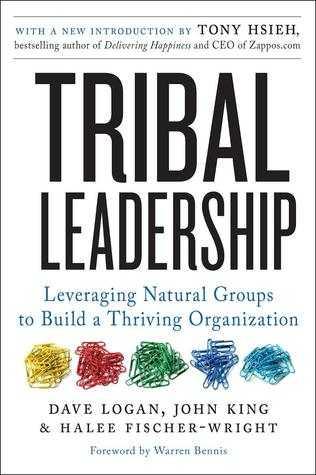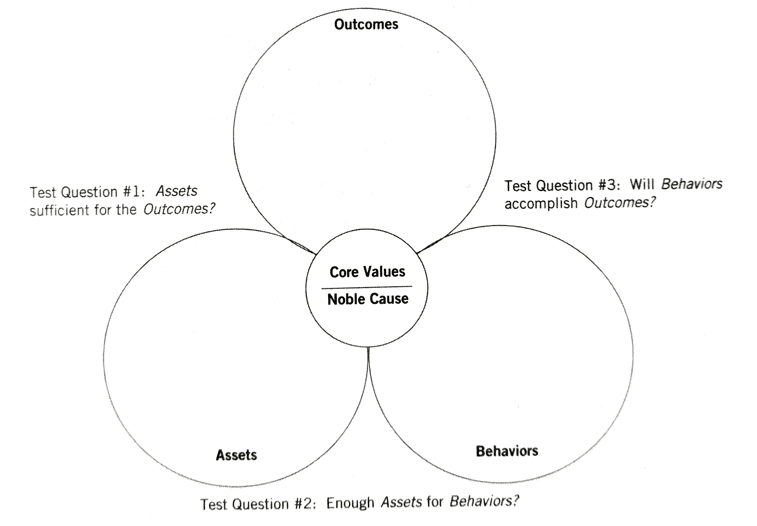Salma 's Key Ideas from Tribal Leadership
by Dave Logan, John King, Halee Fischer-Wright
Ideas, facts & insights covering these topics:
27 ideas
·15.7K reads
71
1
Explore the World's Best Ideas
Join today and uncover 100+ curated journeys from 50+ topics. Unlock access to our mobile app with extensive features.
The Five Key Takeaways
- People don’t use their words, they are used by their words.
- Upgrade the culture. Tribal Leadership focuses on language and behaviour to upgrade the culture.
- Together is better. We start to overcome Stage Three by recognizing that there is no legacy in going at it alone.
- Values come first. Wildly successful organizations talk about values even when it appeared they could least afford to do so.
- Be great at something, world-class if possible.
234
2.15K reads
Corporate Tribes
Tribal Leaders focus their efforts on building the tribe – or, more precisely, upgrading the tribal culture.
Tribal Leadership works when the leader upgrades the tribe as the tribe embraces the leader. Tribes and leaders create each other.
- A tribe is any group of people between about 20 and 150 who know each other enough that, if they saw each other walking down the street, would stop and say “hello.”
- They are likely people in your cell phone and in your email address book.
- A small company is a tribe.
- A large company is a tribe of tribes.
215
1.14K reads
The Tribe: Five Stages
- Without the leaders building the tribe, a culture of mediocrity will prevail. Without an inspired tribe, leaders are impotent.
- You can predict the performance of the tribe by counting the number of people who speak the language of each stage, and noticing who is in positions of leadership.
217
1.11K reads
Stage One
- Very few professionals operate in Stage One, less than 2 percent.
- If Stage One were a t-shirt, it would read “life sucks.”
- People in this stage are despairingly hostile, and they band together to get ahead in a violent and unfair world.
214
1.08K reads
Stage Two
25 percent of workplace tribes display Stage Two as their dominant culture.
“My life sucks” is the adopted attitude.
People are passively antagonistic, no passion, laughter is quiet, sarcastic and resigned. They expect failure.
There is little to no innovation and almost no sense of urgency, and people almost never hold one another accountable for anything.
216
902 reads
Stage Three
- This stage is the dominant culture seen in most workplaces (49%).
- “I’m great, and you’re not” is their slogan.
- Doctors, professors, attorneys, and salespeople are prone to operate at this level.
- Knowledge is power, and so people hoard information.
- They complain about not having enough competent support.
- Common in companies where success is measured on an individual basis.
217
796 reads
Stage Four
There’s a big gap between Stage Three and Stage Four culture.
Stage Four is characterized by “we’re great, and they’re not” and represents 22% of the workforce.
People feel free to be fully themselves. Everyone seems happy, inspired, and genuine.
The bigger the foe, the more powerful the tribe at Stage Four.
217
776 reads
Stage Five
- “Life is great” is the T-shirt slogan for this level.
- Less than 2% of workforces operate at this level.
- Their language revolves around infinite potential and how the group is going to make history – not to beat a competitor, but because doing so will make a global impact.
- This stage is pure leadership, vision, and inspiration. Innovative breakthroughs happen at this level.
220
721 reads
The Tribal Leadership Navigation System
About 75% of workplace tribes operate at Stage Three or below. The goal of this book is to upgrade your tribe to Stage Four.
You determine what stage your tribe is at by listening to how most people talk and noticing how most people structure their work relationships.
- Each cultural stage has its own way of speaking, types of behaviors, and structures of relationships.
- Tribal Leaders do two things:
- Listen for what cultures exist in their tribes
- Upgrade those tribes using specific leverage points
219
607 reads
Stage One: On the Verge of a Meltdown
When people at this stage cluster together, their behaviour expresses despairing hostility.
Leveraging Points:
- If the person is willing to move forward, encourage him to go where the action is. This means having lunch with coworkers, attending social functions, and going to meetings.
- Further, encourage him to notice ways in which life itself works.
- Encourage him to cut ties with people who share the “life sucks” language.
Success Indicators:
- A shift in attitude away from despairing hostility to more passive apathy.
- Cutting social ties with other people who are in Stage One.
215
492 reads
Stage Two: Disconnected and Disengaged
Stage Two has an ineffective relationship with values that comes across as cynicism, sarcasm, or resignation.
They accept obstacles as the way it is and the way it always will be. They give up, and they band together in a sort of support group for the oppressed.
They spend a lot of time making fun of bad managers – “idiot bosses”
Stage Two wants to avoid accountability at all costs and will invent reasons to remain disconnected and disengaged.
216
444 reads
Stage Two: Leverage Points
- Encourage the team member to make a friend. To establish dyadic (two-person) relationships.
- Encourage the team member to establish relationships with people who are at late Stage Three – people who are eager to mentor others into becoming mini-versions of themselves.
- In one-on-one sessions, show the team member how the work that they do does make an impact. Show them areas where they are competent and where their strengths are. Point out abilities they have that are not yet developed, but be careful to make the tone of these discussions positive.
217
401 reads
Stage Three: The Wild, Wild West
- Stage Three is the zone of personal accomplishment.
- It’s also an area where people tend to feel let down by others.
- There’s a perception that people are where they are because they worked for it, and others aren’t there because they gave up.
- People in the middle of stage three have an intense focus on time management since they believe that they can rely only on themselves.
- When people at Stage Three get together, they try to outperform each other.
216
390 reads
Stage Three: Leverage Points
- Encourage projects that are too big to be done alone.
- Point out that the next level of success is going to require a different style than going at it alone.
- When they complain that they (1) don’t have time and (2) other people aren’t as good, show them that they’ve crafted their work life so that no one can really contribute.
- Coach him that real power comes not from knowledge but from networks and that there is more leverage in wisdom than in information.
- Encourage them to manage using transparency.
214
344 reads
The Tribal Leader Epiphany
- Nothing that matters is personal.
- Stage Three has no legacy.
- To win at Stage Three is to win small.
- I now see I have been a manipulator, not a leader.
- I’m tired; isn’t there some other game to play?
- I see myself through others’ eyes, and I don’t like what I see.
217
386 reads
Stage Four: Establishing Tribal Leadership
Rules for Brainstorming:
- Stay focused
- One conversation at a time
- Be visual
- Go for quantity
- Defer judgment
- Encourage wild ideas
218
417 reads
Stage Four: Establish The Culture
- Get a group of like-minded people together and ask how to create or expand a business.
- Look for a group of people within a Stage Three organization who want to play a Stage Four game.
- Ignore organizational boundaries and use tribal antennae to find people who want to create a Stage Four tribe, allowing them to guide the development of the group.
215
332 reads
Core Values and a Noble Cause
- A key point for companies that want to attain Stage Four is to go for values now.
- Almost without exception, we found that wildly successful organizations talked about values when it appeared they could least afford to do so.
- In every case, “we’re great” cultures rested on core values and reached toward a noble cause.
- Many mergers fail because analysts and executives do not consider values and culture but rather think only about the compatibility of business models and balance sheets.
- Tribal Leaders follow the core values of the tribe no matter what the cost.
- Core values are the fuel of a tribe.
215
322 reads
2 Ways to Set a Noble Cause
- Keep asking, “In service of what?”
- Ask the Big Four Questions
- What’s working well?
- What’s not working?
- What can we do to make the things that aren’t working, work?
- Is there anything else?
222
366 reads
2 Ways to Seek Core Values
- A Tribal Leader tells a value-laden story, which triggers others to tell similar stories about their values.
- Ask open-ended questions such as, “What are you proud of?”
217
358 reads
Quarterly Oil Change
- A chance for tribal members to revisit what’s happened, understand events from all sides, resolve issues, and remove any process, system, or habit that’s inconsistent with its values and noble cause.
- Ask the Big Four Questions together as a team.
- Anything not consistent with the core values and noble cause must be reworked or pruned.
214
316 reads
Triads and Stage Four Networking
- Empower others to resolve conflict by reminding them of their shared values.
- Stable triads resolve incidents and free the time of Tribal Leaders to focus on strategy.
- Stage Four organizations actively pull in resources, approaches, consultants, ideas, or anything else that will build the tribe.
- The next time you go to Starbucks, take two friends, not one.
- It’s time for consulting, as an industry, to transition from “consultant-as-expert” to “consultant-as-partner.”
- Stage four assumes trust; they don’t earn it. People grant trust from the beginning.
212
292 reads
Preparing for World-Class Triading
- Get to know the values and current projects of every person in your network.
- Before facilitating an introduction between two people, you have to have the credibility to pull it off. Build credibility through “the theory of small gifts.” Do little things for people, like sending them an article that is about one of their interests, remembering their birthday, etc.
- Be great at something, world-class if possible.
214
294 reads
Outcomes Vs. Goals
- A goal is off in the future. It implies failure in the present. “when we achieve the goal, we will have stopped failing” is how many people relate to the goal-setting process.
- In contrast, an outcome is a present state of success that becomes an even bigger victory over time. An outcome says, “This is what it looks like at this point in the process.”
- Outcomes must be measurable, with a deadline.
- Assets: The Potential for Continued Greatness
214
293 reads
Assets: The Potential for Continued Greatness
- Ask: "What do we have?"
- Core assets are so central to the tribe that they may be invisible to the people inside. Ask, “What do we have a knack for doing better than anyone else?”
- Common ground is another asset that answers the question, “How are we seen by those with whom we want to transact?”
213
319 reads
Behaviours: Strategy in Action
- Ask: "What should we do to accomplish the outcomes?"
- Don’t write down behaviours people are already doing. Focus on behaviours that will bring the outcomes to life.
- Don’t assume everything will go perfectly according to plan. It won’t.
214
365 reads
IDEAS CURATED BY
CURATOR'S NOTE
There are five stages of tribal leadership and each can be identified by the words people use to communicate. This book teaches us to focus on language and behavior to transform disjointed, selfish individuals into a cohesive, selfless team.
“
Salma 's ideas are part of this journey:
Learn more about corporateculture with this collection
The importance of practice and repetition in learning
How to stay motivated and avoid burnout while learning
How to break down complex concepts into manageable parts
Related collections
Different Perspectives Curated by Others from Tribal Leadership
Curious about different takes? Check out our book page to explore multiple unique summaries written by Deepstash curators:
1 idea
Discover Key Ideas from Books on Similar Topics
27 ideas
13 ideas
Extreme Ownership
Jocko Willink, Leif Babin
13 ideas
Coaching for Performance Fifth Edition
Sir John Whitmore, Performance Consultants International
Read & Learn
20x Faster
without
deepstash
with
deepstash
with
deepstash
Personalized microlearning
—
100+ Learning Journeys
—
Access to 200,000+ ideas
—
Access to the mobile app
—
Unlimited idea saving
—
—
Unlimited history
—
—
Unlimited listening to ideas
—
—
Downloading & offline access
—
—
Supercharge your mind with one idea per day
Enter your email and spend 1 minute every day to learn something new.
I agree to receive email updates


